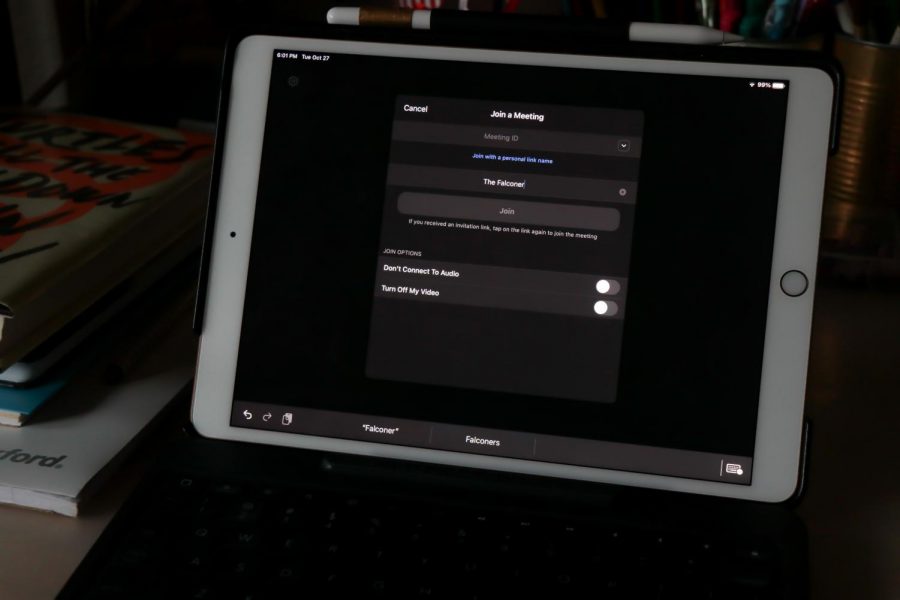Students and Staff Weigh In on the Ups and Downs of Digital Learning
La Salle’s weekly digital learning schedule is composed of four days of synchronous learning with Zoom meetings, and one completely asynchronous day on Wednesday of each week. “I feel like it’s kind of a nice break from Zooms,” freshman Kathleen Waldron said on having asynchronous Wednesdays. “It’s nice to have that day to catch up on work.”
December 9, 2020
Last March, the COVID-19 pandemic sent millions of students and educators across the world into online learning, which remains the dominant method of education months later.
With digital learning this semester, many schools, including La Salle, have adapted a synchronous schedule using Zoom meetings, with the goal of more closely simulating the environment of in-person school and creating a better learning experience than exclusively asynchronous learning.
Most La Salle students attend 14 Zoom classes every week, and each Zoom meeting can last up to 80 minutes. The teacher decides when the Zoom meeting will end, meaning students might spend 10 minutes or the entire 80 minutes in the meeting.
The adjustment to mostly synchronous and entirely virtual learning is an entirely new experience for most students, one that has brought both upsides and downsides.
After a few months of digital learning, three students and two teachers shared their perspectives on the positive and negative sides to digital learning.
Spanish teacher Ms. Lisa Moran found that this year’s schedule makes it easier to teach and engage with students compared to last spring’s schedule.
“I can teach my class just like I would if you were in front of me,” Ms. Moran said.
While some teachers, like Ms. Moran, find this fall’s schedule easier, junior Kat Feise said that she preferred last spring’s asynchronous schedule over the regular Zoom meetings.
“Some of the Zoom meetings can be helpful… [but] I’ve been in Zoom meetings where classes have been 10 minutes,” Feise said. “It just doesn’t make any sense for there to be a Zoom meeting if they’re just going to send us off to do work for the rest of the class period.”
Feise said she feels that staying on Zoom is beneficial for classes like Spanish, as repetition and speaking are major parts of the class, but not as beneficial for classes like English.
English teacher Ms. Stephanie Vermeychuk avoids keeping her students on her Zoom meetings for the entire duration of class, and said that she aims to use the time to communicate crucial information with her students and have meaningful discussions.
“I can’t stay engaged that long in a meeting,” Ms. Vermeychuk said. “I know that it’s hard… I’m not just going to keep us there for the sake of keeping us there.”
Ms. Moran noted that when she teaches in person, the entire duration of a class is not devoted to active teaching.
“I don’t actively teach students the full 90-minute block, so keeping you on Zoom for 80 minutes seems like it defeats the purpose,” Ms. Moran said. “I want [my students] to have some independent work time. My goal is no more than 60 minutes.”
Feise said that, as a junior, she expects rigorous coursework, but consistently feels that her teachers keep her on meetings for too long, leaving her feeling exhausted.
Most sophomores and upperclassmen are accustomed to La Salle’s workload and know other students and teachers, but for freshmen coming from various areas, their first year of high school is an entirely different experience than what it would have been in person.
Freshman Sam Cedros said that he and some of his other classmates have struggled to make friends in Zoom classes. He explained that forming friendships would be much easier if classes were in person. Even as teachers have conducted ice breakers in breakout rooms, Cedros said it’s been difficult for him and other classmates.
“Sometimes people won’t even say anything,” Cedros said. “It would be very awkward, and everyone would have their camera off.”
Freshman Kathleen Waldron said that she also has trouble with connecting with her classmates in breakout rooms.
“I don’t know if breakout rooms have helped me make friends,” Waldron said. “They’re kind of awkward.”
Building community during online learning has been a struggle not just for freshman — teachers and other students have expressed similar difficulties.
“I think one of my strengths as a teacher is that community in the classroom and that’s now gone,” Ms. Vermeychuk said. “It’s really tough for me because [that’s] one of my favorite parts of my job… It seems like people are getting more comfortable with sharing in class. But in terms of community, it’s non-existent, and I can’t imagine being a new student.”
As a new student, Cedros agreed that the aspect of community is lacking within his classes.
“There isn’t a whole lot of community,” he said. Cedros has noticed that people, including himself, try to leave meetings as soon as possible unless they need to speak to the teacher after class.
Ms. Moran said that she has also struggled to build community, especially in her Spanish 2 classes, which are larger than the other classes that she teaches.
“My Spanish 4 and AP class [are] better,” Ms. Moran said. “My AP class [is] just fine. It’s smaller, so there’s not as many [students], and they want to be there.”
In addition to the lack of community many students and staff are experiencing this school year, some students and teachers have found that their workload has increased progressively with synchronous learning.
“The first few weeks I was like, ‘Oh, this isn’t too bad, I don’t have that much,’ but now… Sundays especially are like, ‘Oh, this is just another school day,’” Waldron said.
Last spring, Ms. Vermeychuk found the asynchronous schedule to be too flexible, prompting her to feel unorganized — an issue that this year’s new schedule has somewhat helped with.
“This fall is easier because I feel like I’m staying organized,” Ms. Vermeychuk said. “[But] in many other ways, this is the hardest thing I’ve ever done.”
When it comes to lesson plans, Ms. Vermeychuk said that even though she likes the framework of the new, mostly synchronous schedule, she finds creating agendas for this schedule to be difficult.
“I definitely feel like there’s more mental energy involved in planning just because it’s so unfamiliar still,” she said.
In addition to the mental toll that online learning takes on students and teachers, the physical toll, including issues like fatigue, has become another struggle.
According to Dr. Brenda Wiederhold, a clinical psychologist who spoke to The National Education Association, a big factor contributing to these struggles is the overuse of video conferencing, and the fact that calls are not in current time, with lags and glitches occurring frequently. Dr. Wiederhold said that even just a millisecond delay can cause the brain to find something wrong.
“Our brains are used to picking up body language and other cues, not to mention increases of dopamine, that are experienced during face-to-face communication,” Wiederhold said. “On a video call, something is off, and our subconscious brain is reacting to that. Communication isn’t in real time, even though we may think it is.”
With COVID-19 cases hitting all-time records, it is unlikely that students will be returning to the classroom soon.
Staying hopeful, several students and staff said there are some adaptations that educators, students, and schools could implement moving forward.
Cedros said that he appreciates teachers like Mr. Matthew Shedlock, his English teacher, who only keeps his students in meetings for 30 to 45 minutes, and then allows them to work individually for the rest of the class period.
Waldron pointed out that if spending longer periods of time on Zoom is hard for her, most of her teachers are probably struggling with this aspect of digital learning also.
“I think some of my teachers are understanding [and] they don’t want to be there for the whole time,” Waldron said.
Realistically, Zoom meetings are likely going to be draining for both students and educators, no matter the length they are.
When trying to cope with this fatigue, Wiederhold suggests that students and teachers take breaks between meetings, even urging teachers to reserve a small amount of time in classes for relaxation exercises.
Students recognized that for teachers and school administrators, these are experimental times, and many educators are doing everything they can to make digital learning a positive experience for students.
“I feel like they’re doing the best that they can,” Waldron said.





